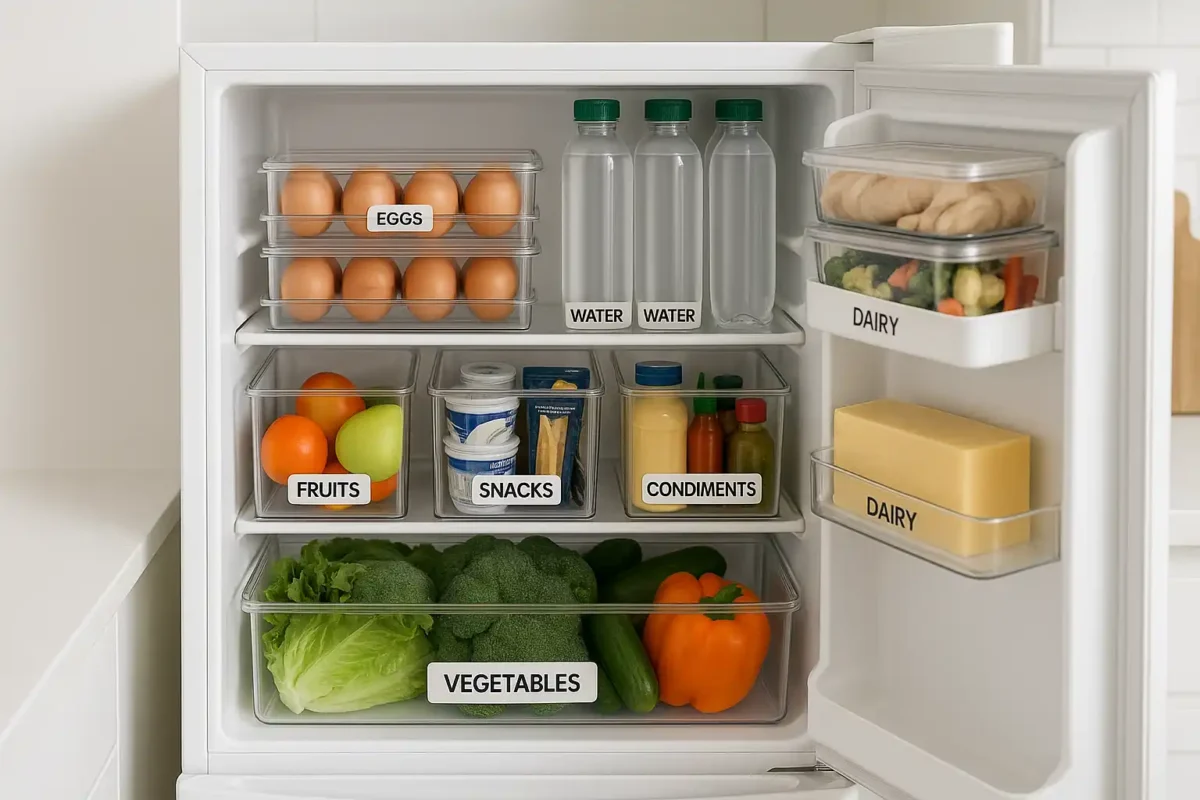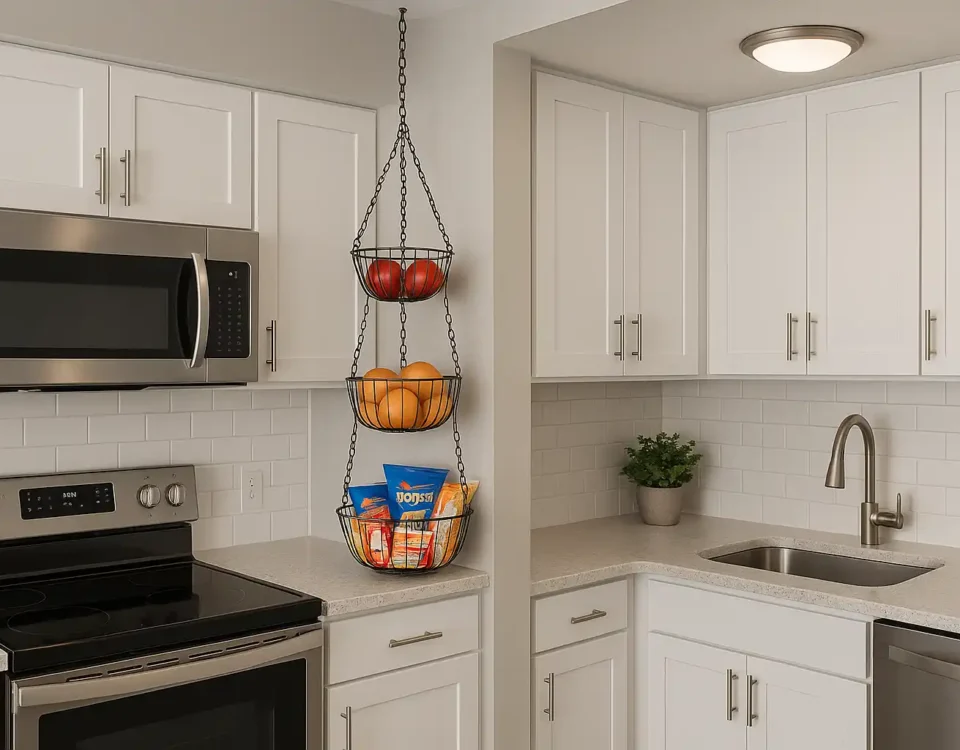
Cheap Pantry Alternatives for Small Apartments
September 13, 2025
DIY Drawer Dividers for Small Kitchens
September 21, 2025Is your mini fridge more like a black hole where good food goes to die? You’re not alone. According to the U.S. Environmental Protection Agency, 30-40% of the US food supply is wasted annually, and small fridge owners are among the biggest culprits. When you’re living in a 400-square-foot apartment or dorm room, that tiny refrigerator becomes ground zero for both frustration and food waste.
But what if you could transform that cramped space into an organized, efficient food storage system that actually makes your life easier? As urban living continues to drive demand for smaller appliances—with the mini fridge market projected to grow from $31.12 million in 2022 to $59.11 million by 2029—mastering small fridge organization isn’t just convenient, it’s essential.

Why Small Fridge Organization Matters More Than Ever
Living in compact spaces comes with unique challenges. Your refrigerator isn’t just storing food—it’s your lifeline to healthy eating, budget management, and reducing environmental impact. When every square inch counts, poor organization leads to:
- Food waste: The EPA estimates 66 million tons of food waste was generated in 2019, with households contributing significantly
- Money loss: The average American family throws away nearly $1,500 worth of food annually
- Stress: Constantly digging through cluttered shelves creates daily frustration
- Health impacts: Disorganized fridges often lead to forgotten groceries and poor meal planning
As J. Kenji López-Alt, renowned food science expert, notes: “Organizing your fridge for maximum efficiency—in terms of food shelf life, food safety, and easy access to the things you reach—changes everything about how you interact with your food.”
The Step-by-Step Small Fridge Organization System
Step 1: The Great Clean-Out (Your Fresh Start)
Before organizing anything, you need a clean slate. Set aside 30 minutes for this crucial first step:
- Remove everything: Place items on your counter grouped by category
- Check expiration dates: Be ruthless—if it’s expired, toss it immediately
- Clean thoroughly: Use a mixture of equal parts water and white vinegar to wipe down all surfaces
- Assess what’s left: This is your reality check—what do you actually use and need?
Pro tip: Keep a donation box nearby for unexpired non-perishables you won’t use. Food banks appreciate sealed items you’ve discovered you don’t actually eat.
Step 2: Master Your Fridge’s Temperature Zones
Small refrigerators often have inconsistent temperature zones. Understanding these micro-climates is crucial for food safety and longevity:
| Zone | Temperature | Best For | Avoid |
|---|---|---|---|
| Top Shelf | 35-38°F (1.7-3.3°C) | Leftovers, drinks, ready-to-eat foods | Raw meat, dairy |
| Middle Shelf | 34-37°F (1.1-2.8°C) | Dairy, eggs, prepared foods | Produce that needs humidity |
| Bottom Shelf | 32-35°F (0-1.7°C) | Raw meat, fish | Ready-to-eat foods |
| Door | 40-45°F (4.4-7.2°C) | Condiments, juice, water | Milk, eggs, highly perishable items |
| Crisper Drawers | Adjustable humidity | Fruits (low humidity), Vegetables (high humidity) | Mixed produce |
Real-life insight: “I used to keep my milk in the door until I learned it’s the warmest part of the fridge,” says Sarah, a Brooklyn renter. “Moving it to the middle shelf doubled how long it stayed fresh.”
Step 3: The Zone-Based Organization Method
Now for the fun part—creating your personalized organization system. This method works for any fridge size but is especially crucial for small spaces:
Zone 1: The Weekly Meal Prep Zone (Top Shelf)
- Dedicate this entire shelf to prepped ingredients and ready-to-eat meals
- Use stackable containers for efficiency
- Label everything with preparation dates
- Why it works: When you’re tired after work, healthy options are immediately visible
Zone 2: The Daily Essentials Zone (Middle Shelf)
- Milk, yogurt, eggs, and other breakfast/daily items
- Keep these at eye level for easy access
- Use clear bins to group similar items
- Why it works: Reduces morning stress and prevents forgotten items
Zone 3: The Raw Protein Zone (Bottom Shelf)
- Raw meat, fish, and poultry
- Store in sealed containers to prevent cross-contamination
- Place on a tray to catch any potential leaks
- Why it works: Prevents foodborne illness and makes meal prep safer
Zone 4: The Condiment Collection (Door)
- Group by usage frequency
- Most-used items at eye level
- Consider a lazy Susan for deeper door shelves
- Why it works: Prevents door overload and makes finding items easier
Zone 5: The Fresh Produce System (Crisper Drawers)
- Separate fruits and vegetables (many fruits emit ethylene gas that ripens veggies faster)
- Use one drawer for high-humidity vegetables (leafy greens, broccoli)
- Use the other for low-humidity fruits (apples, berries)
- Why it works: Extends produce life by up to 40%
Game-Changing Products for Small Fridge Organization
FTC Disclosure: This post contains affiliate links. If you purchase through these links, I may earn a small commission at no additional cost to you.
Best Fridge Organization Products Comparison
| Product | Price | Rating | Pros | Cons | Best For |
|---|---|---|---|---|---|
| mDesign Stackable Fridge Bins | $24.99 | 4.5/5 | Clear design, handles, BPA-free, dishwasher safe | Some users find them smaller than expected | Budget-friendly basic organization |
| SimpleHouseware Lazy Susan | $15.99 | 4.3/5 | 360° rotation, non-slip surface, fits most door shelves | Only holds standard-sized condiments | Condiment organization in deep door shelves |
| OXO Good Grips Greensaver | $19.99 | 4.6/5 | Extend produce life 2-3x, carbon filter, adjustable vent | Higher price point, hand-wash only | People who waste a lot of produce |
| mDesign Over-Fridge Caddy | $34.99 | 4.4/5 | 16 pockets, fits over most mini fridges, extra storage | Requires fridge top clearance | Dorm rooms and very small spaces |
| Chef’s Path Stackable Containers | $29.99 | 4.7/5 | Airtight seals, various sizes, freezer safe | Higher price point, limited color options | Meal preppers and bulk storage needs |
Editor’s Pick: mDesign Stackable Fridge Bins – At under $25, these offer the best value for basic organization needs. The clear design and built-in handles make them perfect for small fridge owners who need maximum visibility.
Budget Pick: SimpleHouseware Lazy Susan – For under $20, this solves one of the biggest small fridge problems: condiments getting lost in the back of door shelves.
Two Unique Hacks You Won’t Find Anywhere Else
Hack #1: The “Meal Prep Cascade” System
Most organization guides tell you to meal prep, but they don’t explain how to store it efficiently in a tiny fridge. Here’s the game-changing method:
- Sunday Prep: Prepare 3-4 base ingredients (grilled chicken, quinoa, roasted vegetables)
- Container Strategy: Use stackable, same-size containers for easy vertical storage
- The Cascade: Arrange containers with Monday’s meal on top, Tuesday’s below it, and so on
- Daily Rotation: Each evening, move tomorrow’s container to the top
Why it works: This system prevents the “forgotten container” syndrome and ensures you actually eat what you prep. One user reported reducing their food waste by 70% using this method alone.
Hack #2: The “Weekly Inventory” Whiteboard Method
This simple tracking system changed everything for small fridge owners:
- Magnetic whiteboard on your fridge door
- List categories: Proteins, Dairy, Produce, Leftovers, Condiments
- Update method: Add items when you buy them, cross off when used
- Weekly review: Every Sunday, review what’s left before shopping
Pro tip: Use different colored markers for different categories. Red for items expiring within 3 days, green for longer-lasting items.
Real-Life Success Stories
Case Study: The College Student
“I was living in a dorm with one of those tiny mini fridges,” shares Mike, a recent graduate. “I was constantly throwing away food because I couldn’t see what I had. After implementing the zone system and using clear bins, I cut my food spending by $40 per month and actually started eating healthier because I could see my fresh produce.”
Case Study: The Urban Renter
“My studio apartment fridge was a disaster zone,” admits Jessica, a marketing professional in Chicago. “I work long hours and would come home too tired to dig through everything. The meal prep cascade system was a game-changer. Now I spend 2 hours on Sunday prepping, and I have healthy meals ready all week. I’ve lost 15 pounds and saved about $200 monthly on food.”
Expert Tips from the trenches
Professional Organizer Insight
“The biggest mistake small fridge owners make is trying to fit too much in,” says professional organizer Marie Kondo-inspired consultant, Lisa Chen. “Your fridge should be 70% full maximum. This allows for proper air circulation, which keeps food fresher longer. Less is truly more when it comes to refrigerator organization.”
Reddit Gold: The “One In, One Out” Rule
From r/organization, a user shared this brilliant tip: “For every new item that goes into my mini fridge, one must come out. This forces me to either eat something I already have or be more mindful about what I buy. It’s completely changed my relationship with grocery shopping and reduced my waste significantly.”
Frequently Asked Questions
What temperature should a small refrigerator be set at?
Small refrigerators should be set between 35-38°F (1.7-3.3°C) for optimal food safety and freshness. Use a separate thermometer to verify, as built-in thermostats can be inaccurate in compact models.
How often should I clean out my small fridge?
For optimal organization and food safety, clean out your small fridge completely every 2-3 weeks. Do a quick wipe-down of spills immediately and check expiration dates weekly.
What are the best containers for small fridge organization?
Clear, stackable, BPA-free containers with similar footprints work best. Look for sets that include various sizes but maintain the same rectangular shape for efficient stacking. Glass containers are more durable but heavier, while plastic is lighter but may stain over time.
How can I maximize door storage in a small refrigerator?
Use a lazy Susan for condiments, group similar items in small bins, and remove unnecessary packaging. Consider magnetic storage for spices and small items that can be attached to the fridge door exterior.
What foods should not be stored in the refrigerator door?
Avoid storing milk, eggs, and highly perishable items in the door, as it’s the warmest part of the refrigerator. These items should be kept on middle or bottom shelves where temperatures are more consistent.
Your Turn to Transform Your Small Fridge
Organizing a small fridge isn’t just about neatness—it’s about reclaiming control over your food, your budget, and your daily routine. With the mini fridge market growing nearly 10% annually, more people are facing this challenge, but now you have the pro-level strategies to master it.
Start with one zone, implement one hack, and build from there. Within two weeks, you’ll wonder how you ever lived with the chaos before. Your small fridge can become your favorite feature of your compact home—efficient, organized, and perfectly suited to your lifestyle.
Ready to start your small fridge transformation? Begin with the Great Clean-Out today, and share your progress in the comments below!
References
- United States Department of Agriculture (USDA). (2023). “Food Waste FAQs.” Retrieved from https://www.usda.gov/about-food/food-safety/food-loss-and-waste/food-waste-faqs
- U.S. Environmental Protection Agency (EPA). (2019). “Food: Material-Specific Data.” Retrieved from https://www.epa.gov/facts-and-figures-about-materials-waste-and-recycling/food-material-specific-data
- Fortune Business Insights. (2023). “U.S. Mini Fridge Market Size & Share.” Retrieved from https://www.fortunebusinessinsights.com/u-s-mini-fridge-market-106824
- Real Simple. (2023). “Here’s the Right Temperature for Your Refrigerator and Freezer.” Retrieved from https://www.realsimple.com/food-recipes/shopping-storing/food/refrigerator-temperature
- López-Alt, J. Kenji. (2023). Expert quote on refrigerator organization efficiency.

